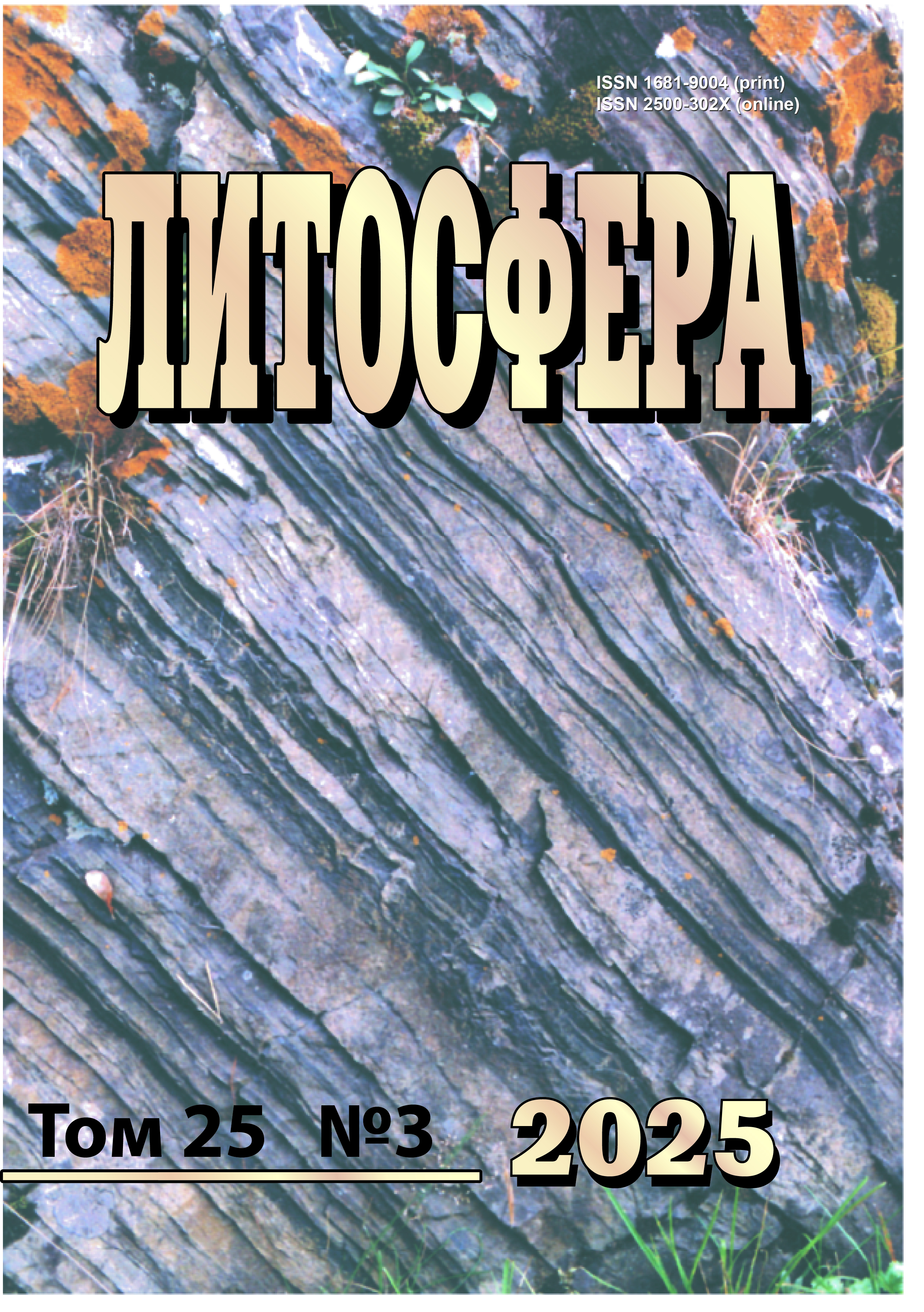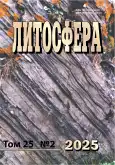Особенности электрофизических свойств гранатов демантоида и андрадита по данным высокотемпературной импедансной спектроскопии: влияние химического состава и фазовых примесей (методические аспекты)
- Авторы: Желуницын И.А.1, Михайловская З.А.1,2, Вотяков С.Л.2
-
Учреждения:
- Институт геологии и геохимии им. академика А.Н. Заварицкого УрО РАН
- Уральский федеральный университет имени первого президента России Б.Н. Ельцина
- Выпуск: Том 25, № 2 (2025)
- Страницы: 281-294
- Раздел: Статьи
- URL: https://journal-vniispk.ru/1681-9004/article/view/311084
- DOI: https://doi.org/10.24930/1681-9004-2025-25-2-281-294
- EDN: https://elibrary.ru/WFNGVY
- ID: 311084
Цитировать
Полный текст
Аннотация
Ключевые слова
Об авторах
И. А. Желуницын
Институт геологии и геохимии им. академика А.Н. Заварицкого УрО РАН
Email: zhelunitsyn@igg.uran.ru
З. А. Михайловская
Институт геологии и геохимии им. академика А.Н. Заварицкого УрО РАН; Уральский федеральный университет имени первого президента России Б.Н. Ельцина
С. Л. Вотяков
Уральский федеральный университет имени первого президента России Б.Н. Ельцина
Список литературы
- Бахтерев В.В. (2004) Оценка формационной принадлежности гипербазитов Урала по параметрам их высокотемпературной электропроводности. Докл. РАН, 398(3), 371-373.
- Бахтерев В.В., Кузнецов А.Ж. (2012) Высокотемпературная электропроводность магнетитовых руд в связи с их генезисом и минеральным составом (на примере Гороблагодатского скарново-магнетитового месторождения). Геология и геофизика, 53(2), 270-276. doi: 10.1016/j.rgg.2011.12.017
- Бахтерев В.В. (2021) Дуниты и клинопироксениты из Кытлымского гипербазитового массива. Результаты исследования высокотемпературной электропроводности. Урал. геофиз. вестник, 1(43), 21-26. doi: 10.25698/UGV.2021.1.3.21
- Пархоменко Э.И. (1965) Электрические свойства горных пород. М.: Наука, 164 с.
- Пархоменко Э.И. (1984) Электрические свойства минералов и горных пород при высоких давлениях и температурах. Дисс. … докт. физ.-мат. наук. М.: Институт физики Земли им. О.Ю. Шмидта, 420 с.
- Ahadnejad V., Krzemnicki M.S., Hirt A.M. (2022) Demantoid from Kerman Province, South-east Iran : A Mineralogical and Gemmological Overview. J. Gemmology, 38(4), 329-347. doi: 10.15506/JoG.2022.38.4.329
- Andrut M., Wildner M. (2001) The crystal chemistry of bire-fringent natural uvarovites: Part I. Optical investigations and UV–VIS–IR absorption spectroscopy. Amer. Miner. 86, 1219-1230. doi: 10.2138/am-2001-1010
- Burns R.G. (1993) Mineralogical applications of crystal field theory (2nd Ed). Cambridge: Cambridge University Press, 551 p. doi: 10.1017/CBO9780511524899
- Dai L., Hu H., Jiang J., Sun W., Li H., Wang M., Vallianatos F., Saltas V. (2020) An overview of the experimental studies on the electrical conductivity of major minerals in the upper mantle and transition zone. Materials, 13(2), 408. doi: 10.3390/ma13020408
- Fullea J. (2017) On joint modelling of electrical conductivity and other geophysical and petrological observables to infer the structure of the lithosphere and underlying upper mantle. Surv. Geophys., 38, 963-1004. doi: 10.1007/s10712-017-9432-4
- Glover P.W.J. (2015) Geophysical properties of the near surface Earth: Electrical properties. Treat. Geophys. (2nd Ed). Vol. 11. Amsterdam: Elsevier, 89-137. doi: 10.1016/B978-0-444-53802-4.00189-5
- Han K., Yi L., Wang D. (2024) Thermal decomposition kinetics of сlinochlore at high temperature and its implications. Can. J. Mineral. Petrol., 62(1),107-116. doi: 10.3749/2300033
- Hassan M.A., Ahmad F., Abd El-Fattah Z.M. (2018) Novel identification of ultraviolet/visible Cr6+/Cr3+ optical transitions in borate glasses J. Alloys Comp., 750, 320-327. doi: 10.1016/j.jallcom.2018.03.351
- Huebner J.S., Dillenburg R.G. (1995) Impedance spectra of hot, dry, silicate minerals and rock: Qualitative interpretation of spectra. Amer. Miner., 80(1), 46-64. doi: 10.1016/10.2138/am-1995-1-206
- Jones R.L., Thrall M., Henderson C.M.B. (2010) Complex impedance spectroscopy and ionic transport properties of natural leucite, K0.90Na0.08O6, as a function of temperature and pressure. Mineral. Mag., 74(3), 507-519. doi: 10.1007/10.1180/minmag.2010.074.3.507
- Irvine J.T.S., Sinclair D.C., West A.R. (1990) Electroceramics: Characterization by impedance spectroscopy. Adv. Mater., 2(3), 132-138. doi: 10.1002/adma.19900020304
- Izawa M.R.M., Cloutis E.A., Rhind T., Mertzman S.A., Poitras J., Applin D.M., Mann P. (2018) Spectral reflectance (0.35–2.5 µm) properties of garnets: Implications for remote sensing detection and characterization. Icarus, 300, 392-410. doi: 10.1016/j.icarus.2017.09.005
- Karato S., Duojun W. (2013) Electrical conductivity of minerals and rocks. Phys. Chem. Deep Earth. U. S.: John Wiley & Sons, 145-182.
- Kubelka P., Munk F. (1931) Ein Beitrag zur Optik der Farbanstriche. Z. Tech. Phys., 12, 593-601.
- Kuganathan N., Ganeshalingam S., Chroneos A. (2020) Defect, transport, and dopant properties of andradite garnet Ca3Fe2Si3O12. AIP Advances, 10, 075004. doi: 10.1063/5.0012594
- Mizuno S., Yao H. (2021) On the electronic transitions of α-Fe2O3 hematite nanoparticles with different size and morphology: Analysis by simultaneous deconvolution of UV–vis absorption and MCD spectra. J. Magn. Magn. Mater., 517, 167389. doi: 10.1016/j.jmmm.2020.167389
- Naif S., Selway K., Murphy B.S., Egbert G., Pommier A. (2021) Electrical conductivity of the lithosphere-asthenosphere system. Phys. Earth Planet. Int., 313, 106661. doi: 10.1016/j.pepi.2021.106661
- Palke A. (2017) Heat treatment of gem quality andradite (var. demantoid): Is intervalence charge transfer necessary for brown coloration in andradite? Geol. Soc. Amer. Abstr. Progr. Washington, USA. doi: 10.1130/abs/2017AM-294617
- Qian Y., Shen Y., Sun F., Chen J., Tang M., Chen F., Chen Y., Sun Y., Shen H. (2024) Improving the UV transmittance of synthetic quartz through defect repair methods. J. Non-Cryst. Solids, 635, 123019. doi: 10.1016/j.jnoncrysol.2024.123019
- Roberts J.J., Tyburczy J.A. (1993) Impedance spectroscopy of single and polycrystalline olivine: Evidence for grain boundary transport. Phys. Chem. Miner., 20, 19-26. doi: 10.1007/BF00202246
- Scheetz B.E., White W.B. (1972) Synthesis and optical absorption spectra of Cr2+-containing orthosilcates. Contrib. Mineral. Petrol., 37, 221-227 doi: 10.1007/BF00373070
- Schlechter E., Stalder R., Behrens H. (2012) Electrical conductivity of H-bearing orthopyroxene single crystals measured with impedance spectroscopy. Phys. Chem. Miner., 39, 531-541. doi: 10.1007/s00269-012-0509-9
- Stockton C.M., Manson D.V. (1983) Gem Andradite Garnets. Gems & Gemology, 19, 202-208. doi: 10.5741/GEMS.19.4.202
- Sun W., Dai L., Li H., Hu H., Jiang J., Liu C. (2019) Experimental study on the electrical properties of carbonaceous slate: A special natural rock with unusually high conductivity at high temperatures and pressures. High Temp.-High Pres., 48, 439-454. doi: 10.32908/hthp.v48.749
- Torrent J., Vidal B. (2002) Diffuse Reflectance Spectroscopy of Iron Oxides. Encycl. Surface Colloid Sci. Vol. 1. N. Y.-Basel: Marcel Dekker Inc., 1438-1446.
- Wang Y., Sun Q., Duan D, Bao X., Liu X. (2019) The study of crystal structure on grossular–andradite solid solution. Minerals, 9(11), 691. doi: 10.3390/min9110691
- Yang X. (2011) Origin of high electrical conductivity in the lower continental crust : A review. Surv. Geophys., 32, 875-903. doi: 10.1007/10.1007/s10712-011-9145-z
- Yoshino T. (2019) Electrical properties of rocks. Encycl. Solid Earth Geophys. Cham: Springer, 1–7. doi: 10.1007/978-3-030-10475-7_45-1
- Yue Y., Dzięgielewska A., Hull S., Krok F., Whiteley R.M., Toms H., Malys M., Zhang M., Abrahams H.Y. (2022) Local structure in a tetravalent-substituent BIMEVOX system: BIGEVOX. J. Mater. Chem. A, 10, 3793-3807. doi: 10.1039/D1TA07547K
- Zhang L. (2017) A review of recent developments in the study of regional lithospheric electrical structure of the Asian continent. Surv. Geophys., 38, 1043-1096. doi: 10.1007/s10712-017-9424-4
- Zhu M., Xie H., Guo J., Bai W., Xu Z. (2001) Impedance spectroscopy analysis on electrical properties of serpentine at high pressure and high temperature. Sci. China Ser. D-Earth Sci., 44(4), 336-345. doi: 10.1007/BF02907104
Дополнительные файлы









